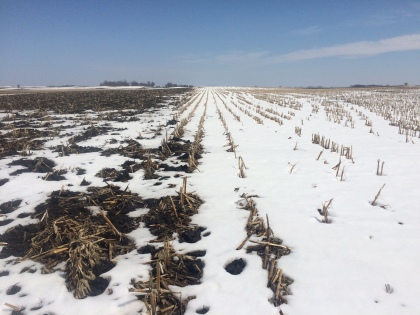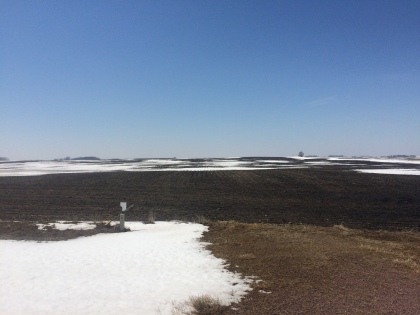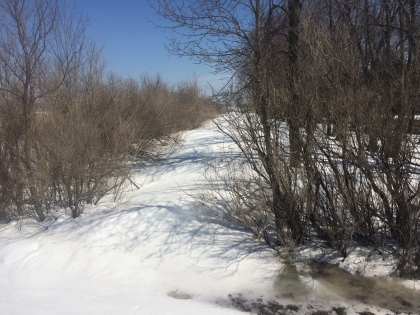This has been a wild spring! First we had lots of snow that didn’t go away, then we had rain that would not quit.
Normally we want to start planting corn about April 23, but it was still cold and wet then. I did finally get started planting on the 7th of May, but I only got 1 acre planted that day. It wasn’t until the 18th of May that I finally got finished planting corn, a full 8 days later than our usual end of planting date.
I got right at it and started planting soybeans on the 20th of May, but then the skies opened up. The field I started to plant got over 4 inch of rainfall that night, and since it is near a creek, all of our neighbors water ran across that field. It was not until the 5th of June before I could get back into that field.
Several times I tried to get soybean planting going again, but it was not until June first that I finally got another field planted. The first week of June stayed mostly dry and I got all of the soybeans planted, about two weeks later than I wanted, but planted.
Between June 6 and June 11 we got 1.3 inches of rain, then 4 days in a row of no rain. I started to get ready to kill some weeds. Then the skies opened. Between June 16 and June 21 we got 6.8 inches of rain, and we had flooded fields.
It is now June 26, 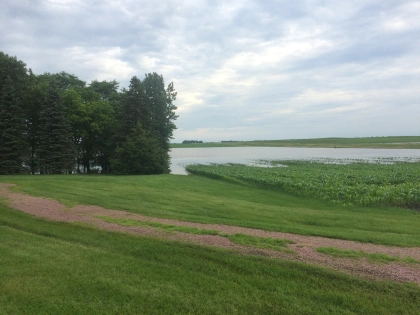 we still have water everywhere. This is north of my dad’s buildings where about 3 feet of water is not going away. We’ll lose crop here.
we still have water everywhere. This is north of my dad’s buildings where about 3 feet of water is not going away. We’ll lose crop here. 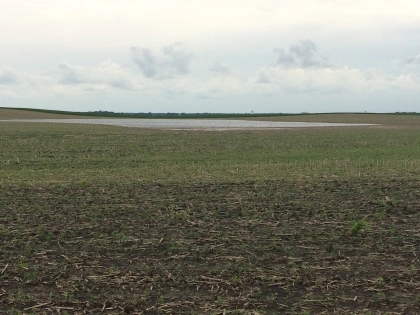 There’s a low spot in this bean field southeast of my house,
There’s a low spot in this bean field southeast of my house,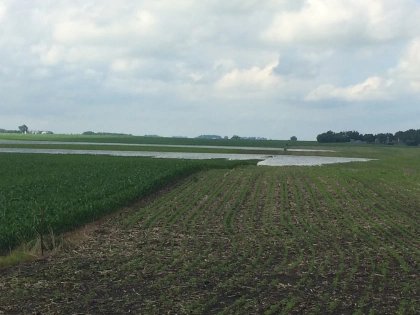 and two ponds in view along my dad’s west fence line.
and two ponds in view along my dad’s west fence line. 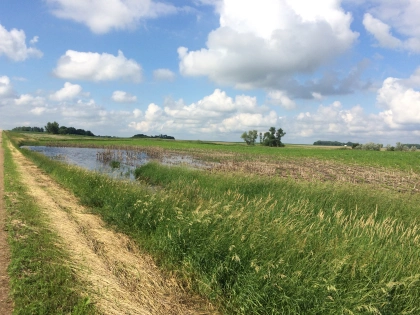 This spot was so wet last fall we could not get it harvested, it still has water in it today. I’m actually amazed that the soybeans look good here since this field got two showers of over 4 inches.
This spot was so wet last fall we could not get it harvested, it still has water in it today. I’m actually amazed that the soybeans look good here since this field got two showers of over 4 inches.
My farm has gotten 9.6 inches of rain so far this month and more is forecast in a day or two. This is definitely a spring for the record books.
Filed under: agriculture, cold, Corn, Farm, farm life, Minnesota, planting, Trees, weather, winter
April 15 was the first day crop insurance covered newly planted corn here in Southwestern Minnesota. Has anyone here started planting corn yet? Not this year! This year we had just received 7 inches of snow on April 14.  In years past some of my neighbors would have planted some of their corn before April 15, not this year!
In years past some of my neighbors would have planted some of their corn before April 15, not this year!
April 22 is the first day that the University of Minnesota recommends planting corn here in Southwestern Minnesota. Will we be planting corn on Monday? Not this year!
This year we still have snow in the fields.
This year a field like this where the snow is mostly melted is hard to find in my neighborhood.
This year a field tree line has a lot of snow on the down wind side where snow piled up when the north winds blew the snow around.
This year groves of trees have 4 feet or more of snow piled up in them which will melt into the fields for a long time yet.
So when do I hope to start planting corn? Who knows. It will not be this month. My hope is to start planting by the normal last day of planting on May 10. If I have to wait to plant corn after May 20 we’ll have to change the varieties of corn I plant. This year may yet go down in the books as the latest I have planted corn, but I do not know the answer to when I will start planting yet, all I can say is not yet.
Filed under: Ag education, agriculture, church, combines, Corn, Farm, farm animals, farm life, food, John Deere, machines, Minnesota, Ondini circuit, planting, science, seasons, Shetek Conference, South Africa, Soybeans, tillage, Tractors, travel, trucks
One of the requests we had made on a previous visit was to spend time with a farmer from South Africa. Some of it is curiosity on our part on how agriculture is done in a larger scale, and the other reason is to get a baseline for what agriculture could be in the Ondini Circuit.
Understand, that this is dryland/irrigated farming on a scale not familiar to us here in southwestern Minnesota. Everywhere we travel in South Africa agriculture is so different. Timber, sugar cane and pineapple are foreign to us. Corn, cattle, hogs, soybeans, barley, wheat and oats we understand.
Our South African farmer host also farms on a different scale than we do. While many in our area farm with only family labor, he has a considerable labor force employed. He, his daughter and son-in-law make up the management team. They have 9 full-time employees and 6 part-time employees. The operation produces white corn, soybeans for seed, black oats for cover crop, pasture and hay, wheat, pumpkins and squash for seed, and cattle to make use of land which can not otherwise be farmed.
Our host grew up speaking German, his daughters married English speakers, and his grandchildren speak Zulu with their friends and in school. Most of his employees are native Zulu speakers.
Keeping employees is one of his hardest tasks. To keep good employees he pays them above normal wages and builds a house for them in town. Employee loyalty is rewarded by advancement as space opens up or need requires.
The 8 row, row crop planter he had in the shed has all of the latest attachments for no-til planting, fertilizing and spraying under GPS guidance. While the size of planter was small by our standards, the availability of labor to keep that planter on the move made it just right for his farm.
The nearly new John Deere tractor in his shed complemented the other smaller and older tractors that populated the farm.
The John Deere combine and sprayer also looked familiar to us.
The truck configuration was different to what we use. We saw very few hopper bottom trucks in our travels, but double trailer and straight truck with a trailer combinations, with steel rather than aluminum frames were everywhere. Road conditions and local road laws are the most likely reason for this difference.
Land does not sit idle in this area of South Africa. When one crop is harvested, the planter is already in the field to plant the next. Irrigated oats keeps cattle graze in peak condition although they do have to add some dried hay to keep the cattle on green grass from getting diarrhea.
Irrigation water for this farm comes from reservoirs sourced in the Drakensberg Mountains. Our host farmer serves on the local water board to help manage that crucial water.
Corn stalks are also used to graze stock cattle when available.
During the summer, when all of the irrigated land is planted to other crops, native grass pastures are used to keep the cattle growing. A feed lot is also on the farm, but it is presently only used for part of the year. That is one place he hopes to make more use of. Right now he only has cattle in the feed lot to meet the Christmas market when local prices are highest.
Most of the cattle he has on hand have bells on them. Although all cattle must be branded to prove ownership, there is the potential for theft. The bells are to help the night guards keep track of cattle movements.
One of our South African church hosts was along for the trip, and was very impressed with all of the science that was needed to farm. That one fact is something that few who do not live on the farm understand. If we are to raise food for the world we must use every bit of science at our disposal. Margins on the farm are razor-thin, to make a profit so we can feed our families and pay our employees is not easy in today’s price environment. That fact is true in South Africa as well as Minnesota.
Filed under: Ag education, children, church, food, food safety, garden, Ondini circuit, planting, school, Shetek Conference, South Africa
Health and wellness issues are a prime reason for these trips we make. A major part of this project is the promotion of gardens. Queen of the gardens and the largest success story is the garden at Hoffenital parish.
Hoffenital parish church has a school nearby, something very common in the area. The uncommon part here is the orphanage and the 13 gogos (grandmothers) who run it. These ladies have started a garden project to help support themselves and the orphans that has become a shining example of what could be.
One of our earliest groups to make the trip to the Ondini helped them along by installing a pump and pipes from a nearby creek to the garden. When the sprinkler system was turned on, the ladies were dancing in the garden for it meant they no longer had to carry water.
Since then the ladies have expanded the garden to the point that they can not only support themselves and the children, but are also paying back by supporting the Zamani Garden Project (an Ondini Circuit, Shetek Conference joint project) that got them going. Now they are taking another step up by expanding the garden.
Now a garden in this area needs fencing since many goats and cattle roam freely in the area. The animals are owned by someone and carry the brands of those owners, but are basically let out to fend for themselves.
The Hoffenital garden was recently granted money to add new fencing, the sod had been turned over by a small tractor and plow, and we were there to help plant about 100 pounds of seed potatoes.
Now the sod could have used a few passes with a disk as far as we farmers were concerned, but it was planting day and plant we would. Trenches were cut by hand with the traditional African hoe which works well for the job, a bit of fertilizer was placed in the trench, potatoes were placed in next and it was covered. A bit of water from a leaky hose was sprinkled over the top and we were done.
I have no doubt that the ladies will have this part of the garden in shape eventually. Labor is cheap, and they have plenty of people looking for work in these rural areas. Members of the congregation volunteer their time to help keep the gardens going, and the parish pastor is likely to bring gifts of garden produce when she makes home visits.
The pastor has her own garden at her parsonage across the valley. Some pastors can support themselves with diligent and energetic use of the garden. It is part of the way they are showing members of their parish what can be done in a garden plot.
Since it rarely freezes here, produce can be grown year round. Cooler season crops like potatoes, carrots and cabbage in the winter and corn, edible beans and squash in the summer. The key here is access to water and fences.
We are proud to be supporting this project with our labor and money. This is something that can really make a difference in this area of Africa.
Next, we make a visit tot he Weenen Game reserve.
The warm weather earlier this spring convinced me that spring was here to stay. I went to work refilling my stack of wood and settled in for the warm weather we expect in spring.
Unfortunately I did not keep access to some of the dryer wood. Now the weather has turned cold, with freezing temperatures in the morning and a forecast of snow for Sunday. That has left me scavenging burnables and searching for dry wood in tree lines. All of this in a time the calendar says I should be planting corn.
Many of my neighbors used the previous warm weather to plant corn. I looked at the weather forecast, checked soil temperatures, looked for barn swallows and tree leaves and decided to wait. I’m not sure how much damage is happening out there in that cold wet ground, but I was not going to chance it. I was not the only one, with many a planter sidelined waiting for needed warmth.
Now the forecast is for snow and two more days of cold. Then the weather reports says spring will be here. If the warm comes as predicted, it looks like I’ll be starting planting this Thursday of Friday, two weeks after those early go getters started putting their corn in the ground. If it will make any difference I do not know. I just know I am happier for having waited.
Filed under: Corn, Farm, Minnesota, planting, rain, seasons, Soybeans, spring, weather | Tags: Corn, Planting, rain, Soybeans, spring, spring rains
After a below normal moisture winter and early spring, the rains have begun to come. We’ve had a little sun, a little rain, and not much for heat. Still corn is beginning to emerge and soybeans to sprout. Every time we get a dry period I see more and more fields that have been planted. We are by no means done with planting here in Southwestern Minnesota, but we are getting closer.
The lack of heat is causing some distress for the corn plants that have emerged. Long periods of cloudy wet weather leave young corn plants looking a bit yellow. Then we get a dry, warmer day or two and the corn plants get a chance to green up as they draw nutrients out of the soil.
Topsoil moisture conditions have improved greatly. Now they are almost a bit too wet when you dig down a few inches. Still the subsoil areas are dry and that keeps the water on the top moving down. I’ve even seen some recovery of small ponds and creeks as the rains continue. That is really good news.
I’m just about done with planting soybeans. I’ve been waiting for a tile repair crew to come into the last area I have to plant. That crew showed up yesterday, and today it rains. So now I wait for a bit more dry and some heat. Once the soil conditions are right I only need part of a day to finish planting. We’ll get the planting done when the weather allows.
Filed under: Corn, Farm, Minnesota, planting, rain, Soybeans, weather | Tags: Corn, dry spell, Minnesota, rain, southwestern minnesota, Soybeans, spring rains
We’ve been in a bit of a dry spell here in Southwestern Minnesota. Our winters snowfall was well below normal and spring rains have been few and far between. This dry spell has allowed us to make record planting progress on our corn and soybeans despite cooler temperatures.
Frankly, I have been more than a little concerned about the dry. Rivers, creeks and lakes are at low levels. Field tile have had some water in them, but not much. Any stirring of the soil surface has created lots of dust. There is some moisture in the soil, but is it enough to keep the crops going? We needed rain!
Today’s weather has helped that immensely. In the last 24 hours we have now had about nine-tenths of an inch of rain. Mostly it came down slowly, just drizzling out of the sky. There were a few episodes where the sky cut loose, but not many. This is just what we needed. Crops will now be off to a good start. When will it rain next?
Filed under: Ag education, cold, Corn, Farm, frost, love, Minnesota, planting, seasons, spring, Trees, weather | Tags: Agriculture education, cold, Corn, farm, Minnesota, nature, Planting, rain, science, spring
It’s April 23, the day the University of Minnesota says those of us who farm in Southwestern Minnesota should start planting corn, but there is still a chill in the earth and I will wait.
The last few mornings have found ice in the cats water dish. Frost on roofs and grass has been obvious. Stick a thermometer into the earth and it will show temperatures still in the 30’s. This is not where I want my seed to be.
I have not as yet seen one dandelion bloom. Crocus, tulip and other early bloomers are not yet budding. Only my pear tree shows blooms, the apples do not, and few trees even show the smallest of leaves. The trees tell me it is cold out there.
There were a few days over a week ago when we had some warm weather, then the insects were out, but most days are bug free. Because there are no bugs there are no barn swallows. Barn swallows swooping around eating insects are a sure sign that the ground is finally warm enough to plant. Yep, all signs say it is still cold in that dirt.
So when will I start planting? I’m not sure yet, but come Monday I’ll check and see how things are going. Frost is finally out of the forecast, but temperatures are not all that warm yet. Also rain is in the forecast for the next few days, that will also slow us down. If we get into May and have not yet started planting then the calendar starts to come into play. We need to get that corn planted by May 10.
Filed under: Farm, Minnesota, planting, rain | Tags: agriculture, Minnesota, rain, spring
It’s looking as if there will be a dry start to this planting season. We went through winter with little snow and have had insufficient rain to really make a difference yet this spring. We do have enough water to get crops started but how long that will last depends on future rain events. Our area of southwestern Minnesota is on the edge of the driest ground getting just a bit below normal rainfall for this month.


